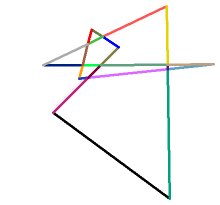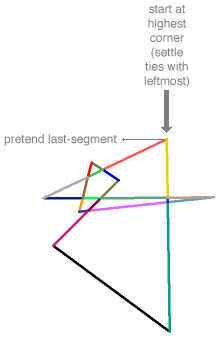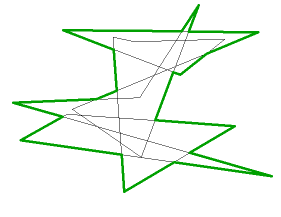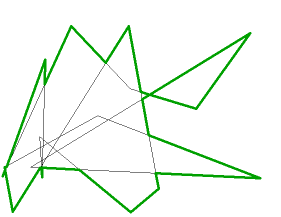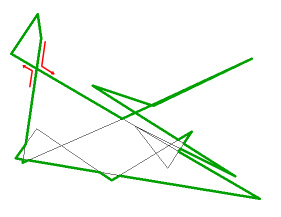// public-domain code by Darel Rex Finley, 2007
// See examples at http://alienryderflex.com/polygon_perimeter
#include <math.h>
#define CIRCLE_RADIANS 6.283185307179586476925286766559
#define MAX_SEGS 1000
// Determine the radian angle of the specified point (as it relates to the
// origin).
//
// Warning: Do not pass zero in both parameters, as this will cause a division-
// by-zero.
double angleOf(double x, double y) {
double dist=sqrt(x*x+y*y) ;
if (y>=0.) return acos( x/dist);
else return acos(-x/dist)+.5*CIRCLE_RADIANS; }
// Returns the perimeter polygon in newX and newY (which must have at least
// MAX_SEGS elements each to prevent the possibility of overrun). "corners" is
// used to pass in the size of the original polygon, and to return the size of
// the new, perimeter polygon.
//
// If for any reason the procedure fails, it will return NO in its bool return
// value, in which case the values in "newX", "newY", and "corners" should not
// be trusted.
bool polygonPerimeter(
double *x, double *y, int *corners, double *newX, double *newY) {
double segSx[MAX_SEGS], segSy[MAX_SEGS], segEx[MAX_SEGS], segEy[MAX_SEGS] ;
double segAngle[MAX_SEGS], intersectX, intersectY ;
double startX=x[0], startY=y[0], lastAngle=.5*CIRCLE_RADIANS, turnAngle ;
double a, b, c, d, e, f, angleDif, bestAngleDif ;
int i, j=(*corners)-1, segs=0 ;
if ((*corners)>MAX_SEGS) return NO;
// 1,3. Reformulate the polygon as a set of line segments, and choose a
// starting point that must be on the perimeter.
for (i=0; i<(*corners); i++) {
if (x[i]!=x[j] || y[i]!=y[j]) {
segSx[segs]=x[i]; segSy[segs]=y[i]; segEx[segs]=x[j]; segEy[segs++]=y[j]; }
j=i;
if (y[i]>startY || y[i]==startY && x[i]<startX) {
startX=x[i]; startY=y[i]; }}
if (segs==0) return NO;
// 2. Break the segments up at their intersection points.
for (i= 0; i<segs-1; i++) {
for (j=i+1; j<segs ; j++) {
if
(lineSegmentIntersection(
segSx[i],segSy[i],segEx[i],segEy[i],
segSx[j],segSy[j],segEx[j],segEy[j],&intersectX,&intersectY)) {
if ((intersectX!=segSx[i] || intersectY!=segSy[i])
&& (intersectX!=segEx[i] || intersectY!=segEy[i])) {
if (segs==MAX_SEGS) return NO;
segSx[segs]=segSx[i] ; segSy[segs ]=segSy[i] ;
segEx[segs]=intersectX; segEy[segs++]=intersectY;
segSx[i ]=intersectX; segSy[i
]=intersectY; }
if ((intersectX!=segSx[j] || intersectY!=segSy[j])
&& (intersectX!=segEx[j] || intersectY!=segEy[j])) {
if (segs==MAX_SEGS) return NO;
segSx[segs]=segSx[j] ; segSy[segs ]=segSy[j] ;
segEx[segs]=intersectX; segEy[segs++]=intersectY;
segSx[j ]=intersectX; segSy[j
]=intersectY; }}}}
// Calculate the angle of each segment.
for (i=0; i<segs; i++) segAngle[i]=angleOf(segEx[i]-segSx[i],segEy[i]-segSy[i]);
// 4. Build the perimeter polygon.
c=startX; d=startY; a=c-1.; b=d; newX[0]=c; newY[0]=d; *corners=1;
while (YES) {
bestAngleDif=CIRCLE_RADIANS;
for (i=0; i<segs; i++) {
if (segSx[i]==c && segSy[i]==d && (segEx[i]!=a || segEy[i]!=b)) {
angleDif=lastAngle-segAngle[i];
while (angleDif>=CIRCLE_RADIANS) angleDif-=CIRCLE_RADIANS;
while (angleDif< 0 ) angleDif+=CIRCLE_RADIANS;
if (angleDif<bestAngleDif) {
bestAngleDif=angleDif; e=segEx[i]; f=segEy[i]; }}
if (segEx[i]==c && segEy[i]==d && (segSx[i]!=a || segSy[i]!=b)) {
angleDif=lastAngle-segAngle[i]+.5*CIRCLE_RADIANS;
while (angleDif>=CIRCLE_RADIANS) angleDif-=CIRCLE_RADIANS;
while (angleDif< 0 ) angleDif+=CIRCLE_RADIANS;
if (angleDif<bestAngleDif) {
bestAngleDif=angleDif; e=segSx[i]; f=segSy[i]; }}}
if ((*corners)>1 && c==newX[0] && d==newY[0] && e==newX[1] && f==newY[1]) {
(*corners)--; return YES; }
if (bestAngleDif==CIRCLE_RADIANS || (*corners)==MAX_SEGS) return NO;
newX[ *corners ]=e; lastAngle-=bestAngleDif+.5*CIRCLE_RADIANS;
newY[(*corners)++]=f; a=c; b=d; c=e; d=f; }}
|

